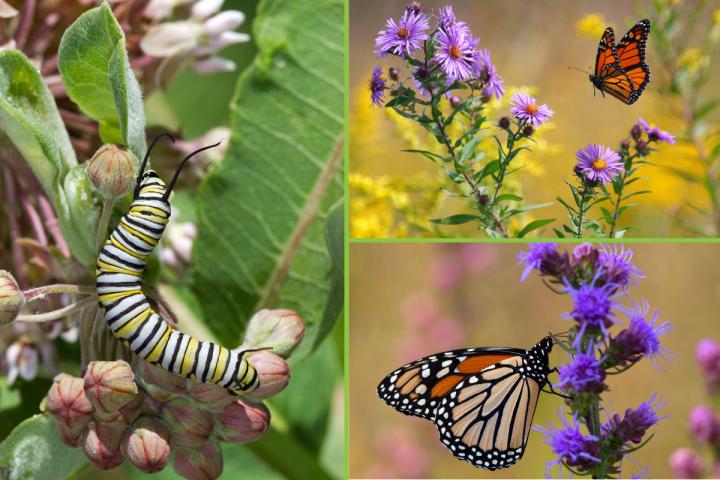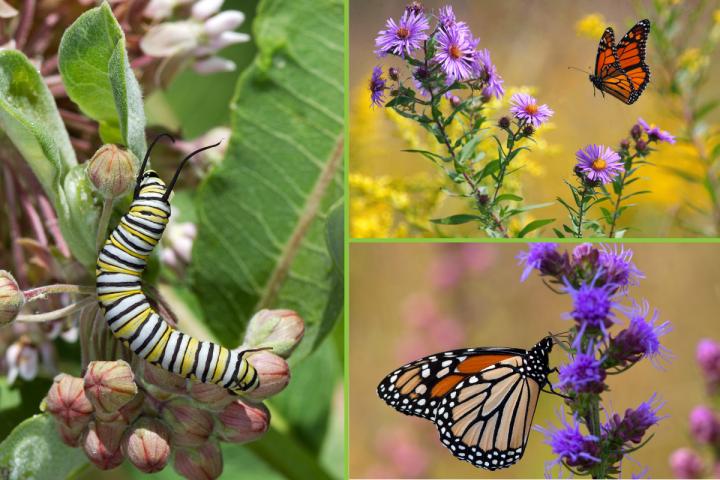
Credit: Photos by Michael Jeffords and Susan Post
CHAMPAIGN, Ill. — Steep declines in the number of monarch butterflies reaching their wintering grounds in Mexico are not fully explained by fewer milkweeds in the northern part of their range, researchers report in a new study.
The research, published in the journal BioScience, reviews decades of studies of monarchs and includes an in-depth analysis of milkweed populations in Illinois, a state at the heart of the butterflies' summer range.
It takes a few generations of monarchs to make the trip north from Mexico to the Midwestern United States and Canada where they summer, but the return trip is a long one. A single generation travels back to the monarchs' wintering ground in Michoacan – flying up to 2,500 miles.
Monarch numbers in Mexico have dropped from a high of 682 million in 1997 to a recent low of 42 million in 2015. Researchers are struggling to understand what is driving the decline. A popular hypothesis is that the loss of milkweeds – the only plants on which monarch larvae can feed – is to blame.
Milkweed losses are tied to the use of herbicide-resistant crops, a practice that began in the late 1990s and allows farmers to apply nonselective herbicides to their fields. Milkweeds are susceptible to glyphosate, the most common herbicide used to protect those crops from weeds.
The new analysis confirmed that milkweed numbers have dropped by about 95 percent in cropland in Illinois over the last 20 years, said Illinois Natural History Survey plant ecologists Greg Spyreas and David Zaya, who conducted the study with research ecologist Ian Pearse, now at the U.S. Geological Survey Fort Collins (Colorado) Science Center. The INHS is a division of the Prairie Research Institute at the University of Illinois.
"But we have more milkweeds in natural areas than previous studies suggested," Zaya said. "I would say the milkweeds in natural areas are buffering the loss of milkweeds in the agricultural areas."
Milkweeds in natural areas also have declined in the past two decades, primarily as a result of the conversion of pastures and other marginal sites to cropland, Zaya said. But the overall drop in the number of milkweeds in Illinois – roughly 50 percent, the researchers found – is not as large as the huge decline in monarch butterflies making it back to Mexico.
Other lines of evidence challenge the notion that milkweeds are the sole cause of monarch declines, the researchers said. Despite smaller numbers leaving Mexico each spring, once they get to Illinois, the monarchs seem to quickly rebound.
"You're talking about as many as 350 million monarchs in peak years across eastern North America," Spyreas said. "Previous studies have found that even when small numbers of monarchs leave Mexico, they're able to rebuild their populations within a couple of generations of reproduction in the summer in the Midwest. That suggests that the supply of milkweed plants here is not the primary problem."
"There are fluctuations in the number of monarchs in the Midwest year to year, but studies suggest there is not an overall decline," Zaya said.
"Conservation efforts also need to look beyond milkweed populations to other possible causes of monarch declines," he said. Habitat loss, disease, parasites and climate change all could be playing a role.
"While boosting milkweed numbers can be part of the solution, I don't think it is the entire solution," Zaya said.
Because the population crashes tend to occur on the way to Mexico, the researchers think a lack of late-flowering nectar sources along the route also may be a significant contributor.
"Monarch adults feed on flowers, including milkweed flowers, before and during their southern migration," Pearse said. "If they are suffering from a lack of nutrition during migration, it could make them more susceptible to other stresses."
"This is what we've found in other extinctions of migratory animals in North America and elsewhere," Zaya said. "It's multiple things coming together to cause this problem. And I think this is along the same lines."
###
The Illinois Department of Natural Resources supported this research.
To reach David Zaya, call 217-244-1946; email [email protected].
To reach Greg Spyreas, call 217-300-4023; email [email protected].
To reach Ian Pearse, call 970-226-9145; email [email protected].
The paper "Long-term trends in Midwestern milkweed abundances and their relevance to monarch butterfly declines" is available online and from the U. of I. News Bureau. DOI: 10.1093/biosci/biw186
Media Contact
Diana Yates
[email protected]
217-333-5802
@NewsAtIllinois
http://www.illinois.edu
############
Story Source: Materials provided by Scienmag





